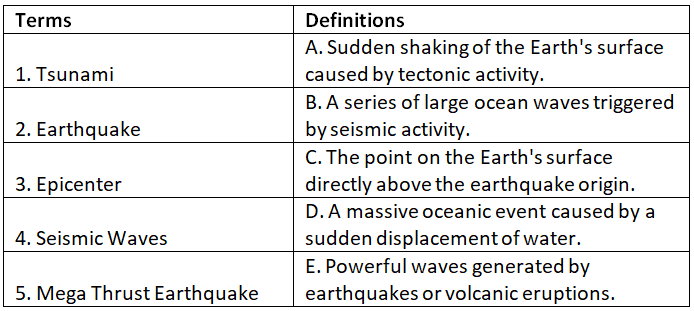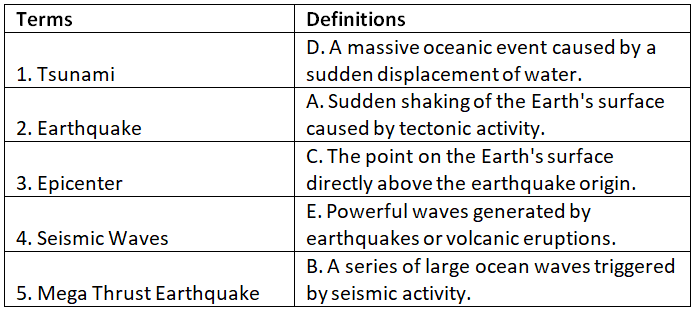Worksheet Solutions: How Tsunamis Work | General Knowledge Encyclopedia - Class 8 PDF Download
| Table of contents |

|
| Section A: Multiple Choice Questions (MCQs) |

|
| Section B: Short Questions |

|
| Section C: Fill in the Blanks |

|
| Section D: True or False |

|
| Section E: Match the Column |

|
Section A: Multiple Choice Questions (MCQs)
Q1: What causes a tsunami?
(a) Volcanic eruptions
(b) Earthquakes
(c) Hurricanes
(d) Tornadoes
Ans: (b)
Explanation: Tsunamis are often caused by underwater earthquakes or volcanic eruptions.
Q2: Tsunamis are most commonly caused by underwater earthquakes along:
(a) The Atlantic Ocean
(b) The Indian Ocean
(c) The Pacific Ocean
(d) The Arctic Ocean
Ans: (c)
Explanation: The Pacific Ocean is known as the "Ring of Fire" due to its high seismic and volcanic activity, making it a common source of tsunamis.
Q3: Which of the following statements about tsunamis is true?
(a) They are small, gentle waves.
(b) They are caused by the gravitational pull of the moon.
(c) They can reach speeds of up to 800 kilometers per hour.
(d) They only occur in coastal areas.
Ans: (c)
Explanation: Tsunamis can travel at extremely high speeds across the ocean, leading to their destructive force when they reach coastal areas.
Q4: Tsunamis can travel across entire ocean basins, spreading outwards from their source. This spreading is known as:
(a) Amplification
(b) Reflection
(c) Dispersion
(d) Diffraction
Ans: (c) Dispersion
Explanation: Dispersion is the spreading of a tsunami wave as it travels across the ocean basin, causing it to lose energy but also covering a larger area.
Q5: What is a common warning sign of an approaching tsunami?
(a) Low tide
(b) High tide
(c) Rainfall
(d) Thunderstorms
Ans: (a)
Explanation: Before a tsunami hits, there is often a sudden and unusual decrease in water levels, leading to low tide. This is a warning sign of an approaching tsunami.
Section B: Short Questions
Q1: Explain the primary cause of a tsunami.
Ans: The primary cause of a tsunami is usually an underwater earthquake. When the tectonic plates beneath the ocean floor suddenly shift, they create a massive displacement of water, resulting in the formation of tsunami waves.
Q2: How are tsunamis different from regular ocean waves?
Ans: Tsunamis differ from regular ocean waves because they have much larger wavelengths and can travel across entire ocean basins without losing much energy. Regular ocean waves are shorter and are not as destructive.
Q3: What are the warning signs of an approaching tsunami that people near the coast should be aware of?
Ans: Warning signs of an approaching tsunami include low tide, the rapid withdrawal of water from the shoreline, the rumbling sound similar to a freight train, and the shaking of the ground during an earthquake.
Q4: Describe the damage caused by a tsunami and its impact on coastal communities.
Ans: Tsunamis can cause extensive damage to coastal communities. The impact includes flooding, destruction of buildings and infrastructure, loss of lives, and disruption of livelihoods.
Q5: What safety measures can be taken to protect oneself from a tsunami?
Ans: To protect oneself from a tsunami, people living in coastal areas should be aware of the natural warning signs, move to higher ground immediately if they experience an earthquake, and have an evacuation plan in place. Public awareness and early warning systems are essential for tsunami preparedness.
Section C: Fill in the Blanks
Q1: Tsunamis are usually caused by ____________ movements in the Earth's crust.
Ans: tectonic
Explanation: Tsunamis are primarily generated by tectonic activities, such as underwater earthquakes, volcanic eruptions, or submarine landslides. When these events occur, there is a sudden displacement of water, leading to the formation of powerful waves known as tsunamis.
Q2: The Japanese word "tsunami" means ____________.
Ans: harbor wave
Explanation: The term "tsunami" is of Japanese origin, and it translates to "harbor wave" in English. This refers to the phenomenon where a series of large waves enter coastal areas, often causing significant damage and destruction.
Q3: Tsunamis have ____________ wavelengths and travel at high speeds.
Ans: long
Explanation: Tsunamis are characterized by their long wavelengths, which can span hundreds of kilometers across the ocean. Due to their large wavelengths and relatively deep water propagation, tsunamis can travel at high speeds, reaching up to 500 to 800 kilometers per hour (km/h) in deep water.
Q4: When a tsunami approaches shallow waters near the coast, its speed ____________.
Ans: decreases
Explanation: As a tsunami approaches shallow coastal waters, its speed decreases while its wave height increases. This phenomenon is known as wave shoaling. Despite the decrease in speed, the energy is compressed, leading to a rise in the height of the waves, which can become extremely dangerous during landfall.
Q5: Tsunamis are different from regular ocean waves because they have ____________.
Ans: larger
Explanation: Tsunamis differ from regular ocean waves in terms of their wavelengths. Regular ocean waves have relatively shorter wavelengths, whereas tsunamis have much larger wavelengths that can extend across entire ocean basins. This is one of the key factors that distinguish tsunamis from ordinary waves and enable them to travel long distances with significant energy.
Section D: True or False
Q1: Tsunamis can be caused by volcanic eruptions.
Ans: True
Explanation: Tsunamis can be triggered by underwater volcanic eruptions.
Q2: Tsunamis are primarily caused by hurricanes and typhoons.
Ans: False
Explanation: Tsunamis are not primarily caused by hurricanes and typhoons; they are mainly triggered by earthquakes and volcanic activity.
Q3: Tsunamis in the open ocean have a very high wave height but low wavelength.
Ans: False
Explanation: In the open ocean, tsunamis have a relatively low wave height but very long wavelengths.
Q4: Tsunamis only occur in the Pacific Ocean.
Ans: False
Explanation: Tsunamis can occur in any ocean or large body of water around the world.
Q5: It is safe to go down to the beach to observe the receding water when a tsunami warning has been issued.
Ans: False
Explanation: When a tsunami warning has been issued, it is essential to evacuate to higher ground immediately and avoid going near the shore to observe receding water, as this can be a sign of an approaching tsunami wave.
Section E: Match the Column

Ans:
|
30 videos|108 docs|27 tests
|
FAQs on Worksheet Solutions: How Tsunamis Work - General Knowledge Encyclopedia - Class 8
| $1. How do tsunamis form? |  |
| $2. Can tsunamis be predicted? |  |
| $3. How fast can a tsunami travel? |  |
| $4. What are the warning signs of a tsunami? |  |
| $5. How can individuals protect themselves during a tsunami? |  |




















